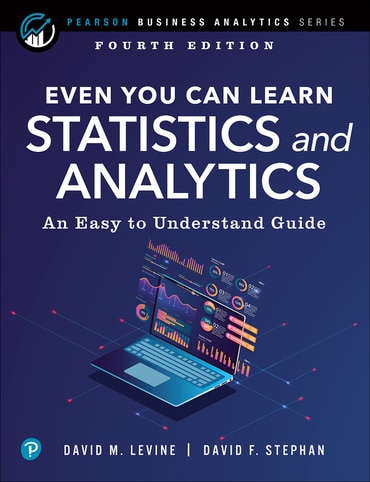
- David M. Levine |
- David F. Stephan |
Title overview
Now fully updated for "big data" analytics and the newest applications, Even You Can Learn Statistics and Analytics, Fourth Edition is the practical, up-to-date introduction to statistics an analytics—for everyone!
One easy step at a time, you'll learn all the statistical techniques you'll need for finance, marketing, quality, science, social science, or anything else. Simple jargon-free explanations help you understand every technique, and realistic examples and worked problems give you all the hands-on practice you'll need. This edition contains more practical examples than ever—all updated for the newest versions of Microsoft Excel. You'll find downloadable practice files, templates, data sets, and sample models—including complete solutions you can put right to work in business, school, or anywhere else. Learn how to do all this, and more:
- Apply statistical techniques to analyze huge data sets and transform them into valuable knowledge
- Construct and interpret statistical charts and tables with Excel or OpenOffice.org Calc 3
- Work with mean, median, mode, standard deviation, Z scores, skewness, and other descriptive statistics
- Use probability and probability distributions
- Work with sampling distributions and confidence intervals
- Test hypotheses with Z, t, chi-square, ANOVA, and other techniques
- Perform powerful regression analysis and modeling
- Use multiple regression to develop models that contain several independent variables
- Master specific statistical techniques for quality and Six Sigma programs
Hate math? No sweat. You'll be amazed at how little you need. Like math? Optional “Equation Blackboard” sections reveal the mathematical foundations of statistics right before your eyes! Thought you couldn't learn statistics? You can—and you will!
- Master all the statistics you need for finance, quality, marketing, social sciences, and modern "big data" analytics—one easy step at a time!
- Includes all-new chapters on analytics concepts and applications, and on descriptive and predictive analytical methods
- Presents expanded discussions and examples based on the latest versions of Microsoft Excel
- Covers descriptive statistics, probability, sampling, hypothesis testing, regression analysis, multiple regressions, Six Sigma statistical quality techniques, and more
- Includes many new and revised problems, both within and at the end of chapters
Table of contents
Author bios
David M. Levine and David F. Stephan are part of a writing team known for their series of business statistics textbooks that include Basic Business Statistics, Business Statistics: A First Course, and Statistics for Managers Using Microsoft Excel. In long teaching careers at Baruch College, both were known for their classroom innovations, with Levine being honored with a Presidential Excellence Award for Distinguished Teaching Award and Stephan granted the privilege to design and develop the College's first computer-based classroom. Both are active members of the Data, Analytics and Statistics Instruction SIG of the Decision Sciences Institute.
Levine is Professor Emeritus of Information Systems at Baruch College. He is nationally recognized innovator in business statistics education and is also the coauthor of Applied Statistics for Engineers and Scientists Using Microsoft Excel and Minitab. Levine is also the author or coauthor of four books about statistical quality management: Statistics for Six Sigma Green Belts and Champions, Six Sigma for Green Belts and Champions, Design for Six Sigma for Green Belts and Champions, and Quality Management, 3rd Edition. He has published articles in various journals, including Psychometrika, The American Statistician, Communications in Statistics, Multivariate Behavioral Research, Journal of Systems Management, Quality Progress, and The American Anthropologist, and has given numerous talks at American Statistical Association, Decision Sciences Institute, and Making Statistics More Effective in Schools of Business conferences.
During his more than 20 years at Baruch College, Stephan devised techniques for teaching computer applications such as Microsoft Excel in a business context and developed future-forward courses that explored the effects of emerging digital technologies. He also served as the associate director of a U.S. Department of Education FIPSE project that successfully integrated interactive media into classroom instruction for the humanities.. Stephan is also the developer of PHStat, the statistics add-in for Microsoft Excel distributed by Pearson Education.